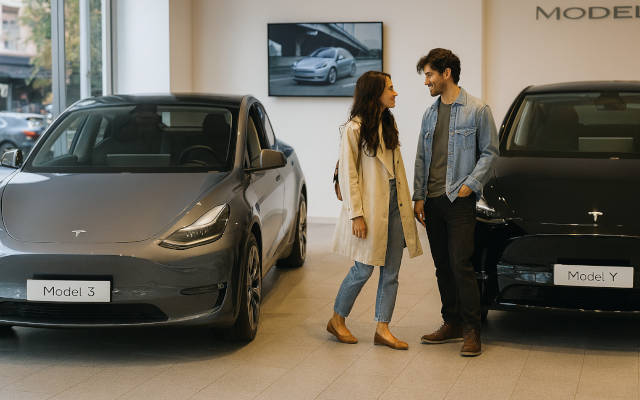 EDITOR'S PICK
EDITOR'S PICK
Auto Giant Stellantis Unveils Revolutionary Battery System Unlocking New EV Era
09 Oct 2025 | Synopsis
 Stellantis unveiled its Intelligent Battery Integrated System (IBIS), merging inverter and charger into the battery for a lighter, more efficient EV powertrain. IBIS boosts energy efficiency by 10%, power output by 15%, and cuts charging time by 15%. Tested in a Peugeot E-3008, it saves weight and space, simplifies maintenance, and eases reuse for energy storage. Stellantis aims for integration by 2030.
Stellantis unveiled its Intelligent Battery Integrated System (IBIS), merging inverter and charger into the battery for a lighter, more efficient EV powertrain. IBIS boosts energy efficiency by 10%, power output by 15%, and cuts charging time by 15%. Tested in a Peugeot E-3008, it saves weight and space, simplifies maintenance, and eases reuse for energy storage. Stellantis aims for integration by 2030.2027 Chevrolet Bolt: The Comeback Kid of Affordable EVs
09 Oct 2025 | Synopsis
 The 2027 Chevrolet Bolt returns as an affordable EV starting at $28,995, now with 150kW fast charging (10–80% in 26 mins), 210 hp, and 255-mile range. Built on the EUV platform, it offers more cargo space and updated tech, including an 11.3" touchscreen and optional Super Cruise. Three trims - LT, LT Comfort, and RS - launch in early 2026 from GM’s Kansas plant.
The 2027 Chevrolet Bolt returns as an affordable EV starting at $28,995, now with 150kW fast charging (10–80% in 26 mins), 210 hp, and 255-mile range. Built on the EUV platform, it offers more cargo space and updated tech, including an 11.3" touchscreen and optional Super Cruise. Three trims - LT, LT Comfort, and RS - launch in early 2026 from GM’s Kansas plant.Tesla's "Cheaper" Sub-$40K Model 3 and Model Y
09 Oct 2025 | Synopsis
 Tesla's new Model 3 and Model Y “Standard” variants, priced under $40K, offer strong range (321 miles) and core tech but cut premium features like powered seats, upgraded audio, and dual motors. The Model 3 is quicker and cheaper, ideal for commuters; the Model Y suits families. Deliveries begin late 2025. While TSLA stock dipped on launch, these models may boost volume and affordability without reinventing the platform.
Tesla's new Model 3 and Model Y “Standard” variants, priced under $40K, offer strong range (321 miles) and core tech but cut premium features like powered seats, upgraded audio, and dual motors. The Model 3 is quicker and cheaper, ideal for commuters; the Model Y suits families. Deliveries begin late 2025. While TSLA stock dipped on launch, these models may boost volume and affordability without reinventing the platform.Hydrogen Hits the Dirt: FIA Extreme H World Cup Debut
08 Oct 2025 | Synopsis
 The FIA Extreme H World Cup debuts in Qiddiya, Saudi Arabia, with hydrogen-powered Pioneer 25 race cars competing across time trials, head-to-head duels, and a final multi-car showdown. Drivers praise the car's performance and reliability, marking hydrogen's first competitive motorsport outing. Seven of eight teams hail from Scandinavia, with Saudi Arabia’s Jameel Motorsport as the local challenger. The event showcases zero-emission racing and Saudi innovation under Vision 2030.
The FIA Extreme H World Cup debuts in Qiddiya, Saudi Arabia, with hydrogen-powered Pioneer 25 race cars competing across time trials, head-to-head duels, and a final multi-car showdown. Drivers praise the car's performance and reliability, marking hydrogen's first competitive motorsport outing. Seven of eight teams hail from Scandinavia, with Saudi Arabia’s Jameel Motorsport as the local challenger. The event showcases zero-emission racing and Saudi innovation under Vision 2030.NY Times Upshot Cost Compares EVs vs. ICE Cars
08 Oct 2025 | Synopsis
 A New York Times Upshot analysis finds electric vehicles are now consistently cheaper to own than gas-powered cars. Lower fuel and maintenance costs, improved battery longevity, and stronger resale values make EVs the more economical choice - even without tax credits. Comparisons across popular models like the Ford F-150 Lightning, Hyundai Ioniq 6, and Tesla Model Y show savings of $5,000–$8,000 over ten years, positioning EVs as the default financial choice for most driver.
A New York Times Upshot analysis finds electric vehicles are now consistently cheaper to own than gas-powered cars. Lower fuel and maintenance costs, improved battery longevity, and stronger resale values make EVs the more economical choice - even without tax credits. Comparisons across popular models like the Ford F-150 Lightning, Hyundai Ioniq 6, and Tesla Model Y show savings of $5,000–$8,000 over ten years, positioning EVs as the default financial choice for most driver.
 Si Exclusive
Si Exclusive
Hydrogen's Flight Path: Fuel Cells, Turbines, and the Economics of Clean Aviation
10 Oct 2025 |  Aviation is shifting from Jet A to four fuel systems: electricity, hydrogen (fuel cell and combustion), SAF, and petroleum. Fuel cells suit short-haul aircraft; hydrogen combustion may power long-range jets. SAF bridges legacy fleets. Hydrogen costs - $5-$7/kg today, possibly $2/kg by 2040 - impact ticket prices and infrastructure decisions. Airport authorities, airlines, and governments will share deployment costs. Each fuel has distinct environmental pros and cons shaping aviation's net-zero future.
Aviation is shifting from Jet A to four fuel systems: electricity, hydrogen (fuel cell and combustion), SAF, and petroleum. Fuel cells suit short-haul aircraft; hydrogen combustion may power long-range jets. SAF bridges legacy fleets. Hydrogen costs - $5-$7/kg today, possibly $2/kg by 2040 - impact ticket prices and infrastructure decisions. Airport authorities, airlines, and governments will share deployment costs. Each fuel has distinct environmental pros and cons shaping aviation's net-zero future.
 10 Oct 2025 23:37:33 UTC |
RECENT PODCASTS
BYD Soars - Cheaper Tesla Models - The Bolt is Back - Rivian
SEARCH RSSTREAM
 53 New Postings In Past 24 Hours
53 New Postings In Past 24 Hours
Category:energy
Region:Europe
Date:29 Sep 2025
Category:mobility
Region:Europe
Date:29 Sep 2025
Category:autonomy
Region:NoAmerica
Date:29 Sep 2025
Category:finance
Region:NoAmerica
Date:29 Sep 2025
Category:mobility
Region:NoAmerica
Date:29 Sep 2025
Category:energy
Region:NoAmerica
Date:29 Sep 2025
Category:finance
Region:NoAmerica
Date:29 Sep 2025
Category:mobility
Region:AsiaPacific
Date:29 Sep 2025
Category:energy
Region:NoAmerica
Date:29 Sep 2025
Category:mobility
Region:NoAmerica
Date:29 Sep 2025